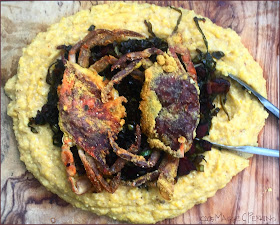Fresh Greek Calamari Scampi Salad with Capers and Sweet Peppers
Prepared for the Texas Farmers' Markets Domain
Prepared for the Texas Farmers' Markets Domain
It was, what it has so infrequently been as of late, a sunny afternoon at the Texas Farmers' Market at Domain, and this bright and lively salad was a perfect pairing for the parting clouds. Simply a riff on a traditional scampi made with shrimp, you'll find this calamari version to be even more simple to prepare than it's inspiration. This hearty entree salad is filling, and versatile-- feel free to add and subtract ingredients according to your preferences-- the addition of red onion, artichoke hearts, young green beans, cherry tomatoes-- they all sound tasty, and save for the lemon, wine, garlic, and calamari, the sky is the limit on variations should you find yourself short on shopping time and an ingredient or two.
My favorite dishes are flexible ones. They know who the boss is around my kitchen and they yield willingly to her tastes. Make sure they yield to yours, too.
Grapeseed Oil-- 2 Tablespoons
Garlic-- 1 small bulb, individual cloves peeled and minced
Scallion-- 1 bunch, sliced greens and whites
Sweet Pepper-- 4-6 young red, yellow, or orange peppers cored, sliced in rings
Butter-- 2 sticks
Parsley-- 1 bunch, chopped
Capers-- 2 tablespoons, drained
Lemon-- juice of 5 large lemons
White wine-- dry, about 1 cup
Prepared calamari rings-- about one pint squid, cleaned, will yield 2 large entree's.(see links, below, for a blog post to help with cleaning, if you're lucky enough to get your hands on fresh from the water whole squid.)
Mixed Field Greens-- 2 cups per entree serving
Saute garlic, scallion, and sweet pepper in grapeseed oil until just tender crisp. Remove, reserve.
In same saucepan, soften butter over medium heat. Stir in parsley, capers, lemon juice, and white wine. Stirring occasionally, maintain at a low boil and reduce liquids-- about five minutes over medium to medium-high heat.
Add calamari rings. Cook until just opaque, 2-3 minutes, stirring frequently. Remove pan from heat.
Mound field greens on dinner plate. Top with sweet pepper mixture, calamari mixture, and ladle butter lemon sauce over salad.
Serving suggestions, below.
Serving Suggestions and a few links:
This substantial entree salad will be sufficient for a full meal, however if you'd like to serve something alongside, how about a warm-weather soup with Greek flavors to complement?
- If you're a bit of a lemonhead like me, Martha Stewart's Avgolemono, a traditional Greek egg and lemon soup, is prepared without the addition of chicken meat, just the broth, and would make a nice addition.
- If that's a little bit of lemon overload for your palate, how about David Chang's Tomato Soup with Olives, Feta and Cucumbers, his personal take on the traditional Greek salad, in soup form.
- Or maybe leave the salad's theme altogether and try Pinch My Salt's Creamy Chilled Cucumber and Avocado Soup.
- If you're feeling ambitious, maybe you'd like to try your hand at some traditional Greek breads, like this Horiatiko Psomi, a crusty country-style bread, or Eliopsomo, a Greek olive bread.
Buying seafood in season from reputable fishmongers who embrace healthy harvesting guidelines is one big step towards ensuring you are consuming, and supporting, sustainable seafood. Learn more about these guidelines and practices from Oceanwise.
Need help cleaning squid? Well pop on over to this quick DIY tutorial and you'll be turning out rings and steaks in no time. It's really very simple.
For more ways to prepare calamari, take a look at Farmers Market Favorite: Mediterranean Lemony Calamari with Stewed Tomato, another quick meal made in under 30 minutes, and look for the upcoming Pan-Fried Crispy Calamari on a bed of Heirloom Tomato and Basil Microgreens, soon to make it's appearance here on Notes from Maggie's Farm.
































